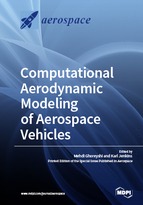Computational Aerodynamic Modeling of Aerospace Vehicles
A special issue of Aerospace (ISSN 2226-4310). This special issue belongs to the section "Aeronautics".
Deadline for manuscript submissions: closed (10 May 2018) | Viewed by 124298
Special Issue Editors
Interests: computational aerodynamics; unsteady aerodynamics; compressible flow; aircraft design; flight dynamics; gas turbine and rocket propulsion; system identification
Special Issues, Collections and Topics in MDPI journals
Interests: turbulent reacting flows; direct-numerical simulations; large-eddy simulations
Special Issues, Collections and Topics in MDPI journals
Special Issue Information
Dear Colleagues,
Currently, the use of computational fluid dynamics (CFD) solutions is considered as the state-of-the-art in the modeling of unsteady nonlinear flow physics and offers an early and improved understanding of air vehicle aerodynamics and stability and control characteristics. This Special Issue of Aerospace covers recent computational efforts on simulation of aerospace vehicles including fighter aircraft, rotorcraft, propeller driven vehicles, unmanned vehicle, projectiles, and air drop configurations. The complex flow physics of these configurations pose significant challenges in CFD modeling. Some of these challenges include prediction of vortical flows and shock waves, rapid maneuvering aircraft with fast moving control surfaces, and interactions between propellers and wing, fluid and structure, boundary layer and shock waves.
Additional topic of interest in this Special Issue is the use of CFD tools in aircraft design and flight mechanics. The problem with these applications is the computational cost involved, particularly if this is viewed as a brute-force calculation of vehicle’s aerodynamics through its flight envelope. To make progress in routinely using of CFD in aircraft design, methods based on sampling, model updating and system identification should be considered. The editor of this Special Issue invites authors to submit papers on addressing the challenges in CFD modeling of various aerospace vehicles and developing methods that will accelerate the generation of aerodynamic models using CFD.
Dr. Mehdi Ghoreyshi
Dr. Karl Jenkins
Guest Editor
Manuscript Submission Information
Manuscripts should be submitted online at www.mdpi.com by registering and logging in to this website. Once you are registered, click here to go to the submission form. Manuscripts can be submitted until the deadline. All submissions that pass pre-check are peer-reviewed. Accepted papers will be published continuously in the journal (as soon as accepted) and will be listed together on the special issue website. Research articles, review articles as well as short communications are invited. For planned papers, a title and short abstract (about 100 words) can be sent to the Editorial Office for announcement on this website.
Submitted manuscripts should not have been published previously, nor be under consideration for publication elsewhere (except conference proceedings papers). All manuscripts are thoroughly refereed through a single-blind peer-review process. A guide for authors and other relevant information for submission of manuscripts is available on the Instructions for Authors page. Aerospace is an international peer-reviewed open access monthly journal published by MDPI.
Please visit the Instructions for Authors page before submitting a manuscript. The Article Processing Charge (APC) for publication in this open access journal is 2400 CHF (Swiss Francs). Submitted papers should be well formatted and use good English. Authors may use MDPI's English editing service prior to publication or during author revisions.
Keywords
- Computational Fluid Dynamics
- Unsteady aerodynamics
- Propeller/wing interaction
- Fluid structure interaction
- Reduced order aerodynamic modeling
- System identification
- Air drop configurations
- Aerodynamic modeling of maneuvering aircraft
- Aerodynamics of missile configurations
- Aerodynamics modeling of control surfaces (overset grid, transpiration boundary condition, grid deformation methods, etc.)
- Gust modeling







